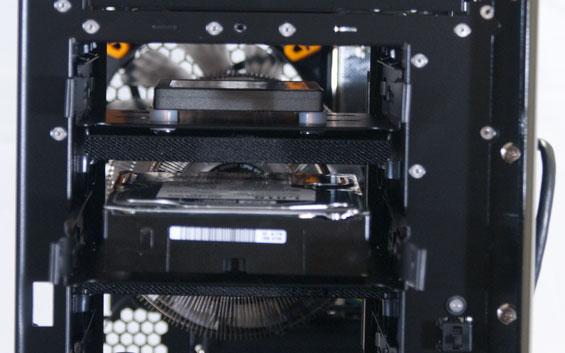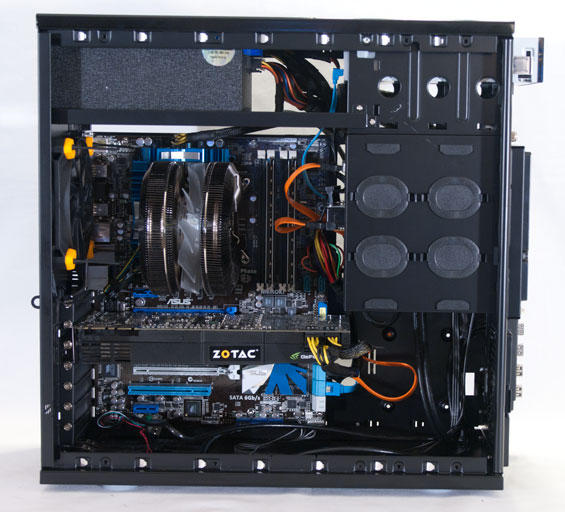Antec Solo II Review: Sonata Evolved
by Dustin Sklavos on September 6, 2011 12:00 AM EST- Posted in
- Cases/Cooling/PSUs
- Antec
- mid-tower
- Sonata
Assembling the Antec Solo II
While Antec has made a lot of strides in at least trying to make the Solo II easy to assemble, I'm not going to lie: I was pretty much dreading actually putting it together once I opened it up. Difficult assembly doesn't necessarily a bad case make (Ed: Says Yoda?); SilverStone produces some incredible cases, but half of the time you don't build them, you solve them.
Ordinarily I'd start by mounting the motherboard, but in the Solo II the absolute first thing you should install is the power supply. SilverStone's Temjin TJ08-E wasn't exactly easy to build either (top-mounted PSUs just seem to be problematic this way), but heaven help you if you ever need to replace your PSU once you've built a system inside the Solo II because you're just not going to be able to fit it around your heatsink. Thankfully the power supply went in alright, and Antec preinstalls most of the mounts for an ATX motherboard by default. The PSU and motherboard were pretty much the easy part.
Update: The Solo II ships with philips head screws attaching the PSU support bar on all sides, so you'll be able to remove the power supply without dismantling the rest of the enclosure.
Antec stashes the drive rails for the two 5.25" drive bays in the bottom of the case, a welcome change that keeps them readily available so that Antec's customer service doesn't have to gracefully send you free replacements (note: they've done that for me as a regular tax-paying ninja before I started doing these reviews). To install the 5.25" drive, along with anything using the 3.5" drive mounts, you'll need to remove the front panel. There are three levers on the inside of the enclosure that you press in, and the front panel actually swings outward on hinges. You're better off just lifting it off and removing it, though.
As much as I appreciate the rails for the optical drive, I've noticed they don't line up quite perfectly by default (you'll see in my completed build that the ODD is recessed), but the real question I have is why this isn't a tool-less installation to begin with. Virtually everybody else has graduated to a tool-less or near-tool-less mounting system for optical drives, but these rails are the exact same ones I installed on my friend's CD burner back when I assembled her AMD Athlon XP 2500+ machine. I wish that were an exaggeration. This needs to be updated desperately.

The press materials suggest hard drives are easy to install and upgrade, but don't you believe it. You have to remove the front panel, then unscrew a hinged ventilation grate (also capable of holding a 120mm intake fan) to get to the drive mounting system. From there you can either strap a 3.5" drive in with the suspension system (I'm not a fan), or you can remove the drive sleds and do it that way. I prefer the drive sleds as they include silicone grommets and can support both 3.5" drives and 2.5" drives. As a nice feature, you still use the grommets for mounting 2.5" drives, a reminder that 2.5" mechanical hard drives still exist (something other case manufacturers often forget), though we'd generally recommend 2.5" SSDs for desktop systems.

Finally, installing the video card was easy enough (as it usually is), but Antec uses old-fashioned screws for mounting instead of thumbscrews. Honestly I'm not sure I care that much either way; I'm terribly frail and generally just don't have the strength to twist thumbscrews unless I'm in a hurry, and I always wind up using a screwdriver anyhow. Cabling was a red nightmare, though, and again I have to stress: modular power supplies are your friend.
I'm keen to point out that SilverStone sent me a little dongle to try out and I've wound up using it in the last two case tests. This cable converts one SATA power cable into four in a neat line, and it is fantastic.
















59 Comments
View All Comments
gevorg - Tuesday, September 6, 2011 - link
"I also think Antec is having the same problem with the Solo II they had with the Sonata IV: it's priced right out of competition. At $129 it just doesn't make sense."It makes sense to people who value silent computing. With the right part selection you can have a powerful computer that is also very quiet and that what makes Solo superb even at $200 price point. Comparing Solo to Sonata is like comparing apple to an orange. Key word: part selection. A proper review with anechoic chamber measurements would show a clearer picture.
zero2dash - Tuesday, September 6, 2011 - link
@ $120 the Solo II is (IMHO) grossly overpriced.@ $200 it's highway robbery and anyone who would buy a Solo at that price point deserves to get ripped off.
If I have $200 and it HAS to be spent on an Antec case, I'd get one of the 18x variants. Otherwise, I'd go with another brand name.
knedle - Tuesday, September 6, 2011 - link
I agree, I have Antec NSK2480 for years and I didn't buy it because it was fancy, featured some neat mounting system or whatever else.I bought it because it looked simple, and was made of thick steel, that helps to make my computer quiet.
Nothing else counts for me, and that enclosure is doing great job for me... Oh wait, I had to turn off all the blue LEDs on it, because I hate them. ;)
pvdw - Tuesday, September 6, 2011 - link
Anandtech just doesn't have the facilities for a proper sound related review of hardware. For that SPCR is a better place to go. If quietness is a priority then that's the place to go for reviews. I've found that their case reviews are better than those here. I'm sure they'll review this case and I look forward to hearing their input.BTW, I have the Solo, and it's a great case! It has it's little foibles, but it's significantly cut down on noise in my office.
As far as tool-less design is concerned, remember that a case like the Solo is geared towards noise reduction. It's possible that some of the tool-less designs lead to extra vibration. Or maybe Antec were just cutting corners.The suspension straps are just the best at reducing HDD vibration transfer.
gevorg - Tuesday, September 6, 2011 - link
"Anandtech just doesn't have the facilities for a proper sound related review of hardware. For that SPCR is a better place to go."If Anandtech can't do a proper review, they shouldn't jump to silly conclusions that Solo "at $129 it just doesn't make sense". Not everything is made for overclockers, storage servers and HTPC.
Dustin Sklavos - Tuesday, September 6, 2011 - link
I stand by my conclusions.Just because we can't invest in a custom built anechoic chamber that produces noise level results which border on academic for 90% of end users, I'm somehow not qualified to be doing these?
davegravy - Tuesday, September 6, 2011 - link
Acoustic Engineer here.Results can be significantly skewed by not measuring in an anechoic environment due to room modes. We're talking on the order of several dB.
Your measurements may still be useful for comparison purposes, provided your transducer location and the location of equipment under test is EXACTLY the same for each measurement. In this case, one should not compare Anantech's results with other published results.
Dustin Sklavos - Tuesday, September 6, 2011 - link
That's basically it. I'm confident that my results are comparable within their own ranks.dhanson8652 - Tuesday, September 6, 2011 - link
I think this is a fair review. I have no major problem with this review and I've been a SPCR regular for almost a decade.Suspension was a big deal with traditional 7200 RPM drives back in the day. With SSDs taking over it becomes less and less of an issue. I'd be fine with suspension taken out of the Solo if it dropped the cost and that was reflected in a lower price for the consumer.
The biggest negative you didn't mention is the power button / reset switch is pretty cheaply made. See the picture in page two of this thread http://www.silentpcreview.com/forums/viewtopic.php... I've seen ham-fisted users bust the power button on a Solo and I've had to fix them so it's not an issue I'll quickly forget.
The one thing that I didn't know before reading this review is that the support bar is removable. There have been some on SPCR that have cut the bar away in the original Solo so having it easily removed/replaced without damaging the cases resale value is a plus.
On the topic of intake the lack of intake fan, considering Yate Loon 120mm fans are only $3 retail (less for someone like Antec to buy in bulk) It'd be very easy to up the included fan count by one if they are going to keep the price that high. As is die hard SPCR types don't use front fans.
leoc - Saturday, December 28, 2013 - link
The really important difference between this review and the SPCR one isn't the precision of the noise recordings. It's that when SPCR found the stock Solo II struggling under load with a mid-range GPU they went ahead, put in a 120mm intake fan and retested. Apparently the Solo II was not only much cooler but quieter with the second fan while under load. Now it would be very fair to slate the expense of what's arguably a $15 hidden extra on the price of a $130 case, but it's faintly absurd not to confirm that the case works well in a two-fan configuration. I understand the desire to review the item as delivered and not to consider esoteric modifications, but throwing in a 120mm Nexus is not exactly drilling holes: it's a ridiculously straightforward and obvious option when self-building a desktop PC for superior noise *or* cooling performance.